State Street, Unisys, GE Capital, KPMG and Leaseplan lead list of companies recognized as E2 Social Business Leaders.

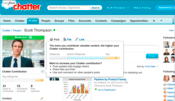
Enterprise Social Networks: Must-Have Features Guide
Enterprise Social Networks: Must-Have Features Guide (click image for larger view and for slideshow)
The companies at the top of our E2 Social Business Leaders list for 2013 are putting social technologies to work on a global scale.
Drum roll, please.
On Friday, I announced State Street Corp. as our E2 Social Business of the Year for 2013. I'm pleased that Kristin Z. Waryas, VP of enterprise social collaboration will be joining me for an onstage interview at the E2 Conference in Boston, June 17-19.
Here is the rest of the top 10 list, with details about each honoree on the pages that follow.
1. State Street Corp. (see my feature interview with Kristin Z. Waryas.)
2. Unisys, Gloria Burke, director of knowledge and collaboration strategy and governance.
3. GE Capital, Ian Forrest, VP global marketing.
4. KPMG, Vishal Agnihotri, associate director, global knowledge services.
5. Leaseplan, Wim de Gier, senior global project manager.
6. DenMat, Jonathan Green, VP of IT.
7. Electrolux, Ralf Larsson, director, employee engagement.
8. Macquarie Group, Silu Modi, VP, digital marketing.
9. Mercer, CIO Harry Van Drunen.
10. Children's Hospital of Philadelphia, Kirsten Culbertson, interactive intranet producer.
These are enterprise social networking stories, with the exception of GE's Access GE customer community and Macquarie Group's social media participation program for financial advisers. GE is pursuing the broader vision of social business that spans both internal and external collaboration, working with Salesforce.com to enhance its Chatter tool to be able to address customer communities as well as internal collaboration.
In addition to Kristin Z. Waryas, two other honorees, Gloria Burke of Unisys and Vishal Agnihotri, will be on hand for the Q&A portion of the social business leaders session at E2. This is your chance to learn from their experience. Burke and Agnihotri will also participate in another panel discussion on Enterprise Social Networking Across Channels, Devices and Languages.
In addition, an E2 session featuring Macquarie's Silu Modi will address social media challenges for financial services firms.

Kristin Waryas' profile on State Street Collaborate
Kristin Waryas' profile on State Street Collaborate
Social Business Leaders 2013
State Street
Unisys
GE Capital
KPMG
Leaseplan
DenMat
Electrolux
Macquarie Group
Mercer
Children's Hospital of Philadelphia
These are really my picks, as the social business chair for E2, since I didn't enlist anyone to help with the judging this time. However, I had some serious debates with myself over the ranking and consider State Street and Unisys essentially tied, each with a great story to tell. The decision came down to a prejudice: I always think technology companies like Unisys ought to make effective use of technology, more so than the rest of us, and so I gave the edge to State Street as a company not in the technology business, but seeking to use it effectively.
We published a call for nominations in February and extended the deadline for nominations into May in search of more and better entries. I also invited entries from some of the organizations, such as Mercer, which I connected with through research for my Social Collaboration for Dummies book, which will be coming out later this year.
By the way, this wasn't supposed to be a contest for vendors, but NewsGator deserves some sort of prize for motivating and mobilizing the members of its community to submit nominations. State Street, Unisys, Mercer and the Children's Hospital of Philadelphia all use the combination of Microsoft SharePoint and NewsGator Social Sites to power social collaboration networks for their employees. They also had good stories to tell about translating social business theory into practice.
Besides, the ability to coordinate action as a community is part of what makes a social business, so I couldn't hold that against them. If you want to be recognized, it helps to speak up. Social business leaders can't be shy.
Read on for more about organizations and their leaders who have something to boast about. Unisys
Unisys was also ranked among our Social Business Leaders Of 2012 and featured last year in a related story, "Unisys Lets Employees Drive Face Of Social Business."
Unisys is taking full advantage of the social capabilities of its platform, but within a wider context. "We want to make sure we don't take such a myopic view of social that we don't see how it touches knowledge management and collaboration," said Gloria Burke, director of knowledge and collaboration strategy and governance.
In other words, even as social networking exposes what otherwise might be tacit knowledge (not written down anywhere), part of the goal should be to capture that knowledge in an organized way. Meanwhile, social connections are most valuable when they lead to more intensive collaboration on projects and innovation.
Enterprise social networking adds a dimension beyond what previous knowledge management and collaboration initiatives were able to accomplish at Unisys by providing access to people, not just documents. Previously, "one of the things we struggled with was we weren't able to find subject matter experts easily, and our sales people can't be experts on everything we sell," Burke said. Now, employees are encouraged to tag their profiles with areas of expertise so they will get an automatic notification when someone posts a query about that topic.
Unisys actually has two social collaboration platforms in play: Chatter for the sales teams, in addition to the NewsGator / SharePoint combination as a company-wide platform. One of the goals for this year is to achieve integration between the two platforms' social streams, so employees on each get the notifications they need to see.
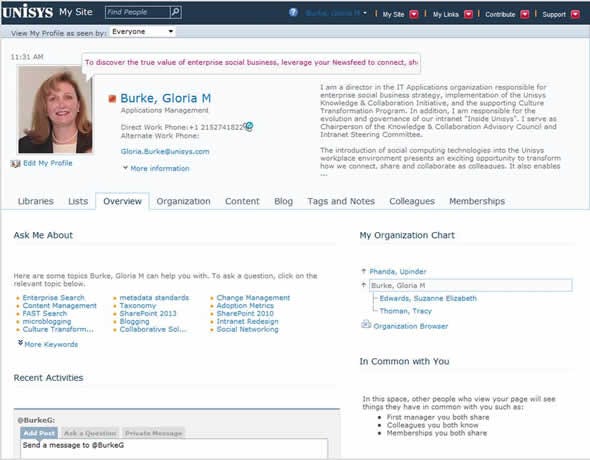
Unisys
Gloria Burke of Unisys
Social Business Leaders 2013
State Street
Unisys
GE Capital
KPMG
Leaseplan
DenMat
Electrolux
Macquarie Group
Mercer
Children's Hospital of Philadelphia
As I mentioned in an earlier E2 preview, Unisys is also pushing for truly global social collaboration, investing in making translation technology available to allow its professionals around the world to express themselves in their own language and consume content in their own language. Spanish and Portuguese are the priorities.
"It's really an all-in proposition -- you can't be just a little social," Burke said. "[Otherwise,] all you're really doing is exchanging content silos for social silos." Each nation's organization will still have its own view of the collaboration system, along with nation-specific news feeds, but the content needs to be managed through a common system, or "you lose that transparency social was supposed to bring to the enterprise," Burke explained. GE Capital
To support a vision of building a community connection with its customers, GE Capital took Salesforce.com's Chatter social collaboration tool and turned it inside out.

Ian Forrest
GE's Ian Forrest
The Access GE community was featured at Salesforce's Dreamforce user conference last year as an example of the potential for extending collaboration to customers and partners. GE was also among the customers cited for bleeding-edge applications of Chatter, such as piping telemetry from its jet engines into the social stream.
GE Capital actually built its customer community before the advent of the Chatter Communities, the product Salesforce.com now promotes for that purpose. "By setting our customers up as internal users, for lack of a better way of doing it, we were able to replicate that functionally before it really existed in what is now the Communities product," said Ian Forrest, VP of global marketing for GE Capital. In the process, GE Capital was able to influence the product development process at Salesforce, and elements of the standardized product were introduced into Access GE in May, a little over a year after the community site went live. The May release also featured other enhancements, such as the introduction of natural language search.
Access GE is more than a Chatter implementation, also tapping into other Salesforce products for marketing and customer support as well as custom and content hosted in the Salesforce cloud. The development project was led by GE Capital CIO Sigal Zarmi.
Building a social community was central to the project.
"Essentially, what differentiates GE Capital from other banks is we're connected to this industrial parent with really great, global expertise," Forrest said. Access GE allows customers to get better access to that expertise, where they can pose questions and get answers from either GE employees or other members of the community. The goal: better business performance for all GE Capital's customers. "If a company is performing better, the odds that we get repaid go up and lowers our risk," Forrest said.
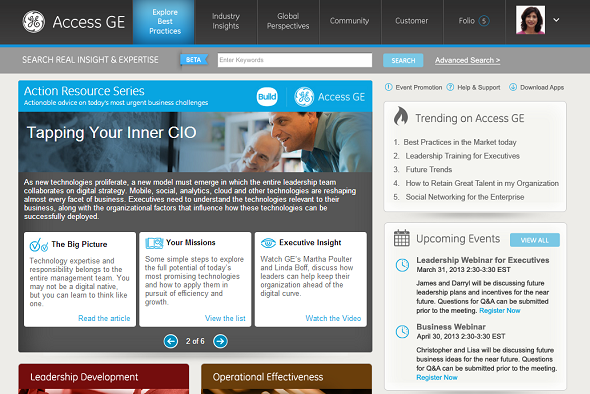
Access GE
The Access GE customer portal.
Social Business Leaders 2013
State Street
Unisys
GE Capital
KPMG
Leaseplan
DenMat
Electrolux
Macquarie Group
Mercer
Children's Hospital of Philadelphia
The concept for Access GE predated Salesforce's involvement. It started with an engagement with innovation and design consulting firm IDEO, Forrest said. "The first version was a bunch of pink and yellow Post-It notes, where we started to describe through pictures how certain features would work. The end design was a template or framework, on paper, of how the experience should be developed."
Why not use one of the social platforms that already targeted external communities, from a vendor like Lithium Technologies or Jive Software? Partly, it was a factor of GE already having a strong partnership with Salesforce.com for other products and internal use of Chatter. Also, the process for provisioning new users can be "an awful process" in other products, while Chatter "just made it turnkey," he said.
Access GE is now used by about 3,800 companies globally, and growth in the user base tends to expand as customers tell others about the service. For example, one cohort consists of Wendy's restaurant franchisees. "They will be on there asking, 'can someone share with me their food cost breakdown?' or 'can you send me a spreadsheet on labor costs' -- all to improve the effectiveness of a single store," Forrest said.
Meanwhile, as a result of connections made through the social portal "we just have a much deeper relationship with the customer as a result of understanding their business issues," Forrest said. That understanding goes beyond recognizing that customers need financing, to understanding why they need it, he said.
KPMG
Part of the reason social business collaboration has taken off within KPMG is because of a few attention-getting examples of how it has paid off.
Within the first few months that the Australian member firm of the global accounting and consulting organization introduced Tibco's Tibbr, the social tool enjoyed phenomenally rapid uptake and adoption from employees looking for better ways to connect and collaborate. What really won attention for the platform during that period was its role in securing a major new client engagement, partly because the sales and consulting teams were able to pull together a proposal quickly, connecting with people and expertise they would have been unlikely to (or less easily) find otherwise.
"Would we have won that deal anyway? Who knows," KPMG's Vishal Agnihotri acknowledged in an interview. Yet those involved had few doubts that social networking had played a role in allowing them to work more effectively, and the connection with winning a big deal also got management's attention.
"Bringing people together in such a large machine is not easy," she said. But by making connections across the personal social networks of many individuals, the online tool "allowed a lot of people to come together and put their expertise together. It's very rare that one service line can answer all the questions a client has," she said.
Tibbr has been boasting about the KPMG Australia success story for a while, but that's not Agnihotri's part of the story. Her job is to take social collaboration global at KPMG -- a big challenge for a decentralized organization made up of member firms in countries around the world. KPMG's global headquarters is in the Netherlands.

KPMG
KPMG's Vishal Agnihotri
Social Business Leaders 2013
State Street
Unisys
GE Capital
KPMG
Leaseplan
DenMat
Electrolux
Macquarie Group
Mercer
Children's Hospital of Philadelphia
"I work in a group called global knowledge," explained Agnihotri, who is based in the U.S. "For anything we roll out, we roll it out for every single member firm in the world. We want to do that for all kinds of reasons, including reducing infrastructure costs and improving knowledge sharing across cross-border boundaries."
The fact that Tibbr had been used successfully in Australia probably won it some points, but the global organization made its decision independently. The original implementation in Australia was actually different, in that it was hosted on premises, inside the firewall, whereas for the global implementation KPMG is using the cloud-hosted version of the software.
Making social collaboration available globally does not mean every member company will take advantage of it, and it's "virtually impossible" to dictate technology choices worldwide, Agnihotri said. In the case of social collaboration, different member organizations have to address different laws related to privacy and security. Those that do join also tend to set different ground rules for employee use of the network -- with one firm imposing a firm approval process for the creation of discussion and interest groups on the network, while the next takes a more free-wheeling approach, she said.
KPMG's global knowledge organization also piloted one of the other leading enterprise social networking products, a broader platform for many forms of collaboration and content sharing in addition to social networking. Ultimately, KPMG decided not to pick a social tool that would compete with other collaboration products in use within the company, such as Microsoft SharePoint. Tibbr is more similar to social tools like Chatter and Socialcast, tightly focused on the social activity stream and conversations, with the ability to link to or embed other intranet content.
"As a professional services firm, our biggest asset actually lies in our people's heads, their knowledge accumulated from multiple client engagements," Agnihotri said. Although KPMG tries to codify some of that through formal knowledge management processes, "it's absolutely impossible to capture every single thing," she said. While there are other ways of calling around or emailing around to get answers, finding the right person to ask is half the battle and "the social network takes care of some of that process."
While the global program may not result in universal adoption, Agnihotri said she does expect the great majority of member firms to participate. That includes Australia, which is in the process of making the switch, she said. "They realized as wonderful as it was to have, if rest of the world was not on it, it wasn't as useful" without having the rest of the organization in the same environment, she said.
KPMG's enterprise social network, internally branded The Hub, is already up and running in the U.S. and a few European firms. "They are finding it increasingly necessary to collaborate under the pressures of the marketplace. The level of sophistication, the level of knowledge that spans multiple countries, that we need requires us to work together." When that doesn't happen, KPMG misses opportunities, she said. Leaseplan
When Leaseplan first introduced social collaboration in 2009, senior project manager Wim de Gier must have been asking himself "What would Google do?"
That early pilot was global and cross-functional, but it only included 170 people, all told. De Gier compared the effect to the way Google initially introduced Gmail, as an invitation-only service where early users were allowed to invite just three other friends. "That creates a big demand," he said in an interview. "It made people very curious to see what's going on." Very soon, he had other employees asking to join the pilot, and he would tell them, "sorry, not allowed." In the process, he accumulated what became a list of "1,000 wannabes" who saw the potential.
"I was able to go to corporate with this list of 1,000 people, so they had no reason not to approve it," he recalled.
Officially launched in 2010, the LinkedPeople enterprise social network based on IBM Connections now helps connect 6,000 employees across 40 subsidiaries in 30 countries. Based in the Netherlands, LeasePlan is one of the leading vehicle leasing and fleet management companies in the world, with more than 1.4 million cars worldwide.
LinkedPeople hosts more than 1,100 communities, 500 blogs and 1,100 forums. It is considered an integral part of business operations, although de Gier conceded it's easier to track social network usage statistics than a direct impact on business productivity. He believes its most significant impact is the creation of a "corporate brain." Without a global collaboration system, finding an expert on a given topic who might be in another country in another business unit would be "pretty much impossible," he said.
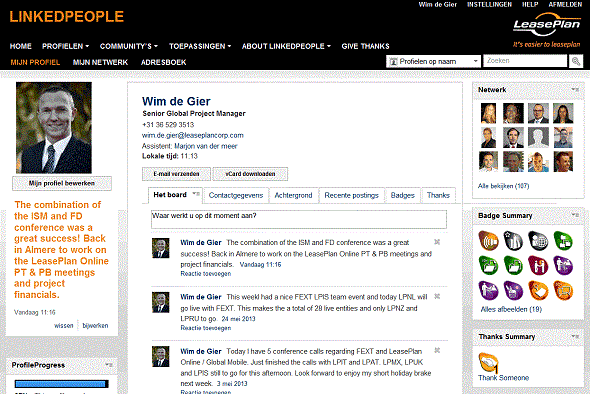
Leaseplan
Leaseplan's Wim de Gier
Social Business Leaders 2013
State Street
Unisys
GE Capital
KPMG
Leaseplan
DenMat
Electrolux
Macquarie Group
Mercer
Children's Hospital of Philadelphia
"By creating global project communities where people can share ideas, there is a big chance to help people stop reinventing the wheel," de Gier said. One current initiative where it is helping is the creation of a single invoice that can be presented to multinational companies that do business with Leaseplan in multiple countries. With better information sharing, that's the sort of thing "that will be adopted by other entities much more easily than it was in the past," he said.
De Gier said he still runs into resistance from executives who say they "don't want Facebook" inside the company. "I have to explain, it's not about Facebook, it's about the corporate brain."
Winning adoption is particularly tough in regions like Eastern Europe where open social collaboration feels foreign to those who grew up fearing a surveillance state, he said. Those employees are coming from a culture where people feared speaking openly to a neighbor or a spouse, he added, "and now 30 years later they're able to be put something into a system where they can blog and read everyone up to the CEO's mind."
That's why it's so important to market social collaboration from the top down, using tools like a video in which CEO Vahid Daemi endorsed LinkedPeople and encouraged open discussion.
The message is to "share your feelings, even if they are bad," de Gier said. "When it's in the open, you are able to change. When it's hidden, you're not able to change it." DenMat Holdings
DenMat was one of the first companies to explore the value of Chatter as a social collaboration extension to the Salesforce.com platform, and continues to use it to connect both employees and the dentists and dental labs that are its channel to market.
I had interviewed DenMat VP of IT Jonathan Green in 2010 for a Forbes.com article on DenMat as an early adopter of Chatter.
"We were one of the beta sites, and it's been a wild ride," Green said in an interview earlier this month.
Founded in 1974, DenMat makes restorative dental and cosmetic products. Green embraced Salesforce.com's CRM platform partly to move away from green-screen terminal software running on an old AS / 400 midrange computer, which was what DenMat used to run manufacturing and sales. Through custom integration with the Force.com platform, he was able to synchronize data between the legacy system and the cloud. However, some users continue to fall back on the old terminal interface because it's what they are used to -- and, honestly, because the shortcut key combinations they have memorized can make it faster for routine tasks than working with a Web-based user interface.
In that environment, "the initial adoption of Chatter was very slow, for fear that it could be used against them," Green said. "But then we would hire new people, and they post everything because they're used to working that way. It takes seeing someone do it and not get in trouble" for others to start to change their minds, he said.
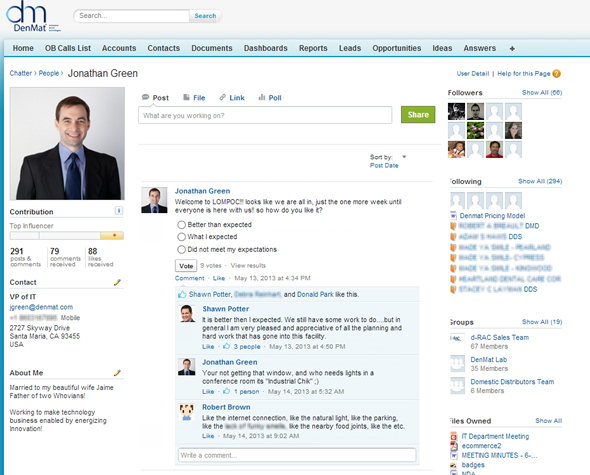
DenMat
Jonathan Green of DenMat
Social Business Leaders 2013
State Street
Unisys
GE Capital
KPMG
Leaseplan
DenMat
Electrolux
Macquarie Group
Mercer
Children's Hospital of Philadelphia
Minds are changing, Green said. An executive who previously was "one of my biggest holdouts" has started posting several times a day after recognizing Chatter as a tool for motivating his team.
DenMat was acquired in late 2011 by a new investment firm, and the new management was initially "very skeptical of Salesforce.com in general," Green said. However, the new leaders couldn't help being impressed by the way Chatter helped them connect with employees across the organization, he said. "Now, they want every customer-facing touchpoint to be through Salesforce." Electrolux
When Electrolux surveyed users about the value of its enterprise social network, director of employee engagement Ralf Larsson admits he was initially disappointed by the lack of enthusiasm.
Yet as he dug further into the results he found reasons for optimism. "About 29% of the employees gave a totally different rating -- they were so much more positive about everything," he said in an interview. "We need to get that 29% to become 100%, once they've seen the value of collaborating in new ways," he added. "That doesn't happen by default."
Electrolux makes consumer and professional appliances, including the Frigidaire line of refrigerators. The company is headquartered in Stockholm, Sweden, with operations worldwide. Its social collaboration platform, based on IBM Connections but with Electrolux branding, attracted more than 17,000 visitors in 2012, an increase of more than 300% from 2011, with an increasing share of that traffic coming from mobile devices. The number of employees with a device who actively visit a social space every month increased from 5% in 2011 to 55% in 2013. The target audience includes 61,000 employees in 60 countries.
"My title is engagement," noted Larsson, who reports up through corporate communications. "My job is finding new ways for Electrolux to connect to more employees in more ways -- find them, connect them, get to do something. That something might be crowdsourcing or idea generation. The point is to connect more and better with employees and get them to do the right things."

Electrolux's Ralf Larsson, director, employee engagement
Social Business Leaders 2013
State Street
Unisys
GE Capital
KPMG
Leaseplan
DenMat
Electrolux
Macquarie Group
Mercer
Children's Hospital of Philadelphia
IBM Connections was chosen partly to replace a Lotus Notes database "with something more modern," Larsson said. "We wanted to support more conversational interactions with other parts of the business, and we also had a group of top 20 leaders who wanted a place to discuss sustainability issues within the organization."
Electrolux also uses SharePoint, typically for "larger projects where there are a lot of documents," Larsson said. Meanwhile, IBM Connections "is the more people-centric social layer."
One challenge of working with the IBM platform is its breadth and depth, which employees sometimes find overwhelming, Larsson said. To make it more approachable, one of the things he has been working on is a "five things you need to know" training program that dispenses discrete tips like how to share files, or how to get the Connections app set up on an Android phone.
"If we can provide a few tips and tricks on our side, then they can expand from there," he said. Macquarie Group
Most of the social business leaders profiled here are pushing hard to get more people on their platforms.
Not so for Silu Modi, VP of digital marketing for Macquarie Group, who oversees a social media marketing and prospecting program for financial advisers seeking customers for the firm's private wealth management services. "I'm looking at total audience of 40, at tops 50, advisers -- but every single one of them using it well."
Modi works for the Canadian subsidiary of Macquarie, which is based in Australia. Until 2011, company policy prohibited advisers from practicing their profession in social media for regulatory reasons. That policy has been relaxed somewhat with the use of Actiance Socialite, a social media management tool designed for use in regulated industries where communications with customers and potential customers must be monitored and archived. Still, the advisers who use the tool are operating out in public where they can potentially get themselves -- and the company -- in a lot of trouble by saying the wrong thing.
The program that allows supervised access to Twitter, LinkedIn and other social sites started with just four advisers and has been expanding at the rate of another four every six months or so. Modi said he may pick up the pace to add five or six advisers every six months, but probably won't go beyond that.
"I don't believe in social for every one of our advisers, just like seminars are not for every one of [our] advisers," he said. "If you want to be part of [the] social program, you have to have had a blog going for a while. You need some digital savvy and you need to be able to write something for yourself -- where you don't need someone else writing your tweets for you. You're going to be a spokesperson for the brand, so you have to be able to complete a well-formed, well-written sentence."

Silu Modi of Macquarie
Social Business Leaders 2013
State Street
Unisys
GE Capital
KPMG
Leaseplan
DenMat
Electrolux
Macquarie Group
Mercer
Children's Hospital of Philadelphia
Ghostwriting social content doesn't work, especially for financial professionals. If a potential client likes what the adviser posted, the failure to be able to discuss that topic on follow-up leads to "cognitive dissonance" that kills sales, Modi said. "The person writing this stuff has to be the person you're going to meet in real life."
The most talented investment advisers tend to have their own strong opinions in any case and not want to merely distribute press releases. Those selected for the social media program are given a tutorial on the relevant regulations and what they can and can't say. For the first six months of the program, everything they post has to be pre-approved for compliance before it goes live. If they get through six months of the program with no more than three rejections, they graduate to "post moderation," meaning they are trusted to post their own content, subject to spot checking after the fact.
While there is a pent-up demand from advisers who want to get into the program, particularly after hearing tales of how it brought in big contracts, the role of social needs to be kept in perspective, Modi said. "I don't think anybody in their right mind is going to invest a half million with an adviser because of a pithy tweet." Instead, the smart adviser who goes prospecting works all the online and offline channels available "until somewhere on the path they hit a tipping point -- after four, five, six, eight, nine touchpoints, you hit on something that takes them over the edge." Mercer
The impetus for Mercer's enterprise social network came from the very top of the company -- although the CEO didn't ask for social collaboration in so many words, CIO Harry Van Drunen said.
The mandate from president and CEO Julio A. Portalatin was "a little broader than that," Van Drunen said. "He was looking for employee engagement and innovation within the organization and better ways to foster innovation."
Mercer is a global management consulting firm that helps other companies design benefits plans and employee programs. While its social collaboration initiative is still young, "among Fortune 500 companies, we've got a story that is as good or better than most," Van Drunen said.
This executive push for engagement and innovation came in early 2012, shortly after Van Drunen had shelved a planned SharePoint upgrade for budgetary reasons. Now, he dusted off those plans and took a closer look at how NewsGator's social platform in combination with SharePoint could accelerate progress toward Portalatin's business goal.
"I bundled together a business case, got approval in April and went live the first week in November," Van Drunen said. That was a "real burn" from an IT perspective, he added. "You only get that stuff done in a hurry if you have executive sponsorship," both because of the technology work required and the "work within the business."
Since then, Portalatin has become probably the most active user of the platform's social capabilities, blogging about strategy and inviting employees to comment back, Van Drunen said. "He's embracing the opportunity."
Getting the rest of the company to mirror that enthusiasm is more challenging, Van Drunen said. "What we've learned through the process is it does not magically happen." For social collaboration to be productive, people have to come back on a regular basis, and they won't do that if things get stale, he said. That requires not only adoption but active participation and productive use, he said.

Mercer CIO Harry Van Drunen
Social Business Leaders 2013
State Street
Unisys
GE Capital
KPMG
Leaseplan
DenMat
Electrolux
Macquarie Group
Mercer
Children's Hospital of Philadelphia
Part of the process of winning active employee participation has been making sure everyone understands the ground rules. Early on, employees were presented with a series of "quick guide" documents on what was and was not appropriate behavior on the social network.
Marcia Robinson, leader of Mercer's Global Knowledge Management team, said Facebook and Twitter users took to the collaboration network more easily, but they still needed guidance on what was and was not appropriate. Her short version: "You should not be microblogging that you had Corn Flakes for breakfast, but you could post that you had Corn Flakes for breakfast with the CEO and here is what he said."
At the same time, other employees were afraid to post, partly because they were not clear where their posts would show up or who would see them, said Barbara Fiorillo, the enterprise content management leader on Robinson's team. Posting to the main corporate feed "can be scary for people, putting yourself out there like that -- knowing your boss sees it.
In Mercer's social collaboration setup, based on SharePoint and NewsGator Social Sites, all employees are automatically assigned followers including their primary supervisor and departmental coworkers.
"I think we've been really good about creating a culture that says it's okay to post -- and don't worry if there's a typo," she said. Still, employees needed guidance about what to post where -- whether in the company-wide stream or a group for a particular professional interest -- and who would see it. So her team created a "Who Sees My Post" infographic showing how widely visible a post will be, depending on where it is posted and how it is tagged.
In addition to calming fears about broadcasting too widely, this summary helped employees understand how to tag their posts to get them seen by the right people.
That seems to be happening, as employees report making productive connections they would not have made otherwise, Van Drunen said. Although formal measurement of the program's success will be important going forward, for now he asks employees to think of how many people they would have had to contact to get the answer to a question a few years ago, versus today. Children's Hospital of Philadelphia
Prior to adding a social element, the Children's Hospital of Philadelphia already had a collaboration system in place in SharePoint. The only problem: few people knew about it.
Meanwhile, email was a much more inefficient way of doing group collaboration, but it was the tool everybody knew about and knew how to use. That's the basic thing the hospital decided to change by implementing the combination of NewsGator and SharePoint.
Yes, this is one last NewsGator story. True, the deficiencies the hospital saw in SharePoint dated back to its SharePoint 2007 implementation, and the SharePoint 2013 edition includes more out-of-the-box social functionality.
Yet selecting NewsGator as a layer on top of SharePoint proved to be a good decision, said Kirsten Culbertson, interactive intranet producer at the hospital and leader of the project. "NewsGator has faster cycles -- they're improving every three months -- whereas it takes I don't know how many years before SharePoint provides a new version. NewsGator also comes with more tools than SharePoint [alone] can offer us right now," she said.
After implementing NewsGator atop SharePoint 2010 last year, the hospital is in the process of upgrading to SharePoint 2013 and the latest version of NewsGator, she said.
"What we're finding is younger employees are getting in there right away, and within a day they'll have 400 connections," Culbertson said. "For the rest of us, it's going to take additional encouragement." That means end-user training, as well as discussions with the management and directors of the hospital about the significance of social collaboration. "A lot of the work we've been doing is kind of political in nature," she added.
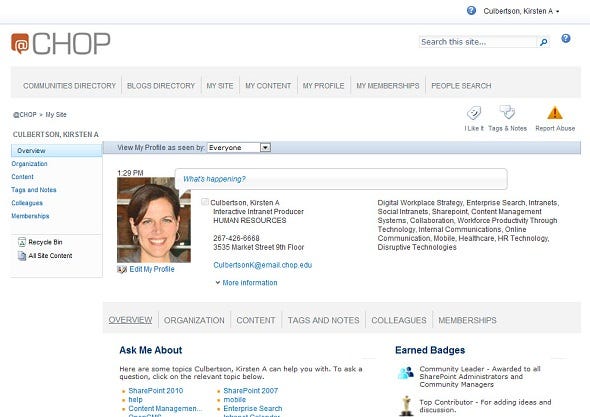
Kirsten Culbertson's CHOP profile
Social Business Leaders 2013
State Street
Unisys
GE Capital
KPMG
Leaseplan
DenMat
Electrolux
Macquarie Group
Mercer
Children's Hospital of Philadelphia
Examples of successful uses include:
-- A CIO Blog, run by information services employees, which invites comments.
-- New Employee Orientation Community, a place for new employees to network and find answers.
-- Faculty Development Community, an asynchronous learning environment.
-- Nursing Wiki, providing support and information for employee development.
-- SafeKeeping Community, a forum on enhancing patient safety.
One of the drawbacks of the way SharePoint was used in the past was that collaboration was limited to tight-knit teams and "did not allow for users to see what any other groups were doing," Culbertson said. At the same time, SharePoint previously had been approved for applications including those involving storing sensitive patient data -- which made sense as long as those collaboration sites were isolated. That all needs to be rethought in the social environment, she said, although she believes it ultimately should be possible to manage patient health information through more tightly secured communities on the platform.
Culbertson works in internal communications, although she has also been working with other departments such as human resources on initiatives such as using the social network as part of employee training. Employee profiles are being enriched with data pulled from a Lawson human resources information system and a likely next step will be integrating with a performance management system.
The goal is to "create a clear picture of each employee and their skill set and what their accomplishments are," Culbertson said. "What we're doing right now is a lot bigger than just improving communications across the organization."
About the Author(s)
You May Also Like







